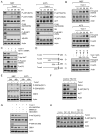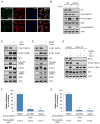Focal Adhesion- and IGF1R-Dependent Survival and Migratory Pathways Mediate Tumor Resistance to mTORC1/2 Inhibition
- PMID: 28757207
- PMCID: PMC5698809
- DOI: 10.1016/j.molcel.2017.06.033
Focal Adhesion- and IGF1R-Dependent Survival and Migratory Pathways Mediate Tumor Resistance to mTORC1/2 Inhibition
Abstract
Aberrant signaling by the mammalian target of rapamycin (mTOR) contributes to the devastating features of cancer cells. Thus, mTOR is a critical therapeutic target and catalytic inhibitors are being investigated as anti-cancer drugs. Although mTOR inhibitors initially block cell proliferation, cell viability and migration in some cancer cells are quickly restored. Despite sustained inhibition of mTORC1/2 signaling, Akt, a kinase regulating cell survival and migration, regains phosphorylation at its regulatory sites. Mechanistically, mTORC1/2 inhibition promotes reorganization of integrin/focal adhesion kinase-mediated adhesomes, induction of IGFR/IR-dependent PI3K activation, and Akt phosphorylation via an integrin/FAK/IGFR-dependent process. This resistance mechanism contributes to xenograft tumor cell growth, which is prevented with mTOR plus IGFR inhibitors, supporting this combination as a therapeutic approach for cancers.
Keywords: Akt; dual mTORC1/2 inhibition; mTORC1; mTORC2; tumor resistance.
Copyright © 2017 Elsevier Inc. All rights reserved.
Conflict of interest statement
The authors declare no potential conflicts of interest.
Figures







Similar articles
-
Endothelial Cell mTOR Complex-2 Regulates Sprouting Angiogenesis.PLoS One. 2015 Aug 21;10(8):e0135245. doi: 10.1371/journal.pone.0135245. eCollection 2015. PLoS One. 2015. PMID: 26295809 Free PMC article.
-
AZD2014, an Inhibitor of mTORC1 and mTORC2, Is Highly Effective in ER+ Breast Cancer When Administered Using Intermittent or Continuous Schedules.Mol Cancer Ther. 2015 Nov;14(11):2508-18. doi: 10.1158/1535-7163.MCT-15-0365. Epub 2015 Sep 10. Mol Cancer Ther. 2015. PMID: 26358751
-
A dual mTORC1 and mTORC2 inhibitor shows antitumor activity in esophageal squamous cell carcinoma cells and sensitizes them to cisplatin.Anticancer Drugs. 2013 Oct;24(9):889-98. doi: 10.1097/CAD.0b013e328363c64e. Anticancer Drugs. 2013. PMID: 23838676
-
The Enigma of Rapamycin Dosage.Mol Cancer Ther. 2016 Mar;15(3):347-53. doi: 10.1158/1535-7163.MCT-15-0720. Epub 2016 Feb 25. Mol Cancer Ther. 2016. PMID: 26916116 Free PMC article. Review.
-
Disentangling the signaling pathways of mTOR complexes, mTORC1 and mTORC2, as a therapeutic target in glioblastoma.Adv Biol Regul. 2022 Jan;83:100854. doi: 10.1016/j.jbior.2021.100854. Epub 2021 Dec 6. Adv Biol Regul. 2022. PMID: 34996736 Review.
Cited by
-
Glioma actively orchestrate a self-advantageous extracellular matrix to promote recurrence and progression.BMC Cancer. 2024 Aug 8;24(1):974. doi: 10.1186/s12885-024-12751-3. BMC Cancer. 2024. PMID: 39118096 Free PMC article. Review.
-
Repurposing the serotonin agonist Tegaserod as an anticancer agent in melanoma: molecular mechanisms and clinical implications.J Exp Clin Cancer Res. 2020 Feb 21;39(1):38. doi: 10.1186/s13046-020-1539-7. J Exp Clin Cancer Res. 2020. PMID: 32085796 Free PMC article.
-
mTOR inhibition reprograms cellular proteostasis by regulating eIF3D-mediated selective mRNA translation and promotes cell phenotype switching.Cell Rep. 2023 Aug 29;42(8):112868. doi: 10.1016/j.celrep.2023.112868. Epub 2023 Jul 25. Cell Rep. 2023. PMID: 37494188 Free PMC article.
-
NUAK1 coordinates growth factor-dependent activation of mTORC2 and Akt signaling.Cell Biosci. 2023 Dec 22;13(1):232. doi: 10.1186/s13578-023-01185-2. Cell Biosci. 2023. PMID: 38135881 Free PMC article.
-
P2 × 7 Receptor Inhibits Astroglial Autophagy via Regulating FAK- and PHLPP1/2-Mediated AKT-S473 Phosphorylation Following Kainic Acid-Induced Seizures.Int J Mol Sci. 2020 Sep 4;21(18):6476. doi: 10.3390/ijms21186476. Int J Mol Sci. 2020. PMID: 32899862 Free PMC article.
References
-
- Benjamin D, Colombi M, Moroni C, Hall MN. Rapamycin passes the torch: a new generation of mTOR inhibitors. Nat Rev Drug Discov. 2011;10:868–880. - PubMed
-
- Bentzinger CF, Romanino K, Cloetta D, Lin S, Mascarenhas JB, Oliveri F, Xia J, Casanova E, Costa CF, Brink M, et al. Skeletal muscle-specific ablation of raptor, but not of rictor, causes metabolic changes and results in muscle dystrophy. Cell Metab. 2008;8:411–424. - PubMed
-
- Braunstein S, Karpisheva K, Pola C, Goldberg J, Hochman T, Yee H, Cangiarella J, Arju R, Formenti SC, Schneider RJ. A hypoxia-controlled cap-dependent to cap-independent translation switch in breast cancer. Mol Cell. 2007;28:501–512. - PubMed
MeSH terms
Substances
Grants and funding
LinkOut - more resources
Full Text Sources
Other Literature Sources
Medical
Molecular Biology Databases
Miscellaneous

